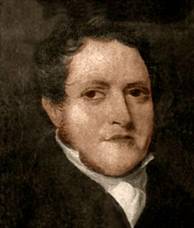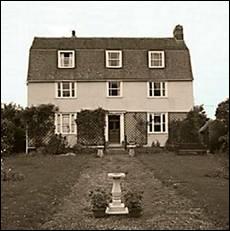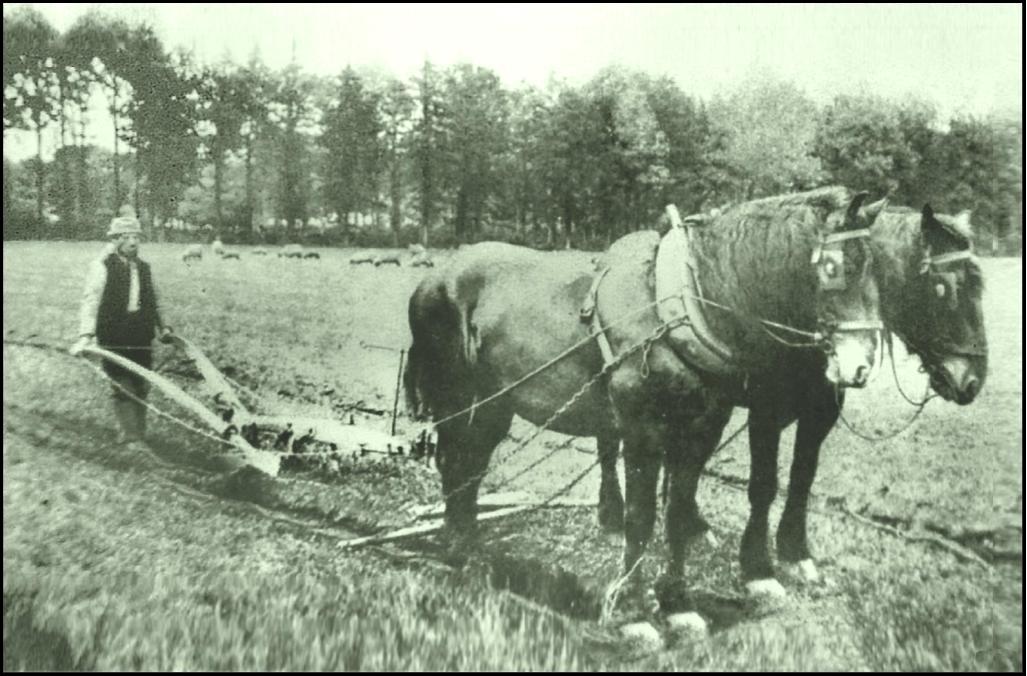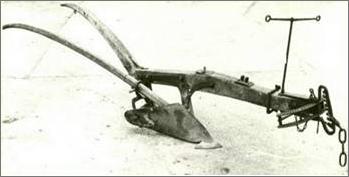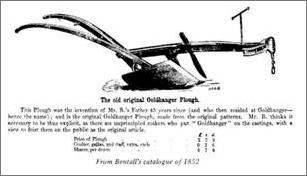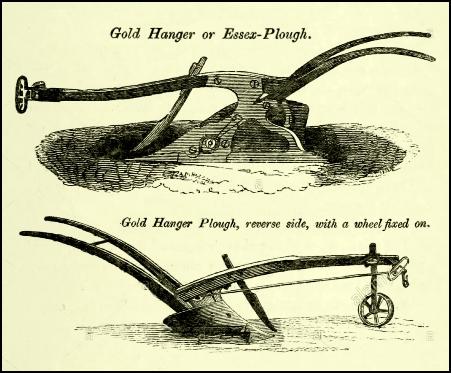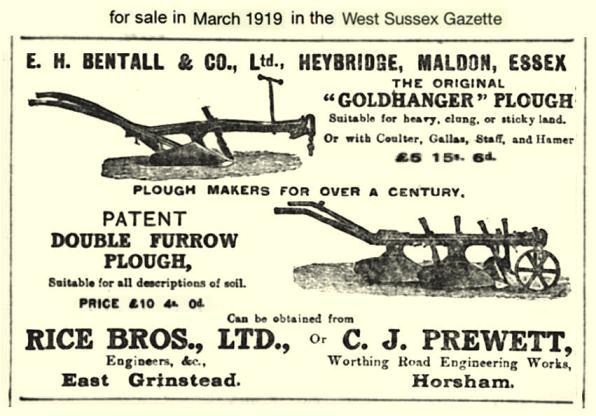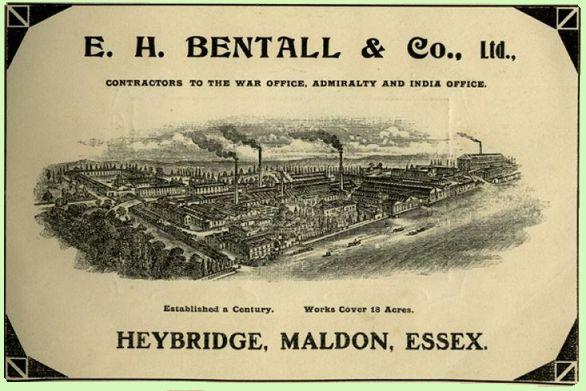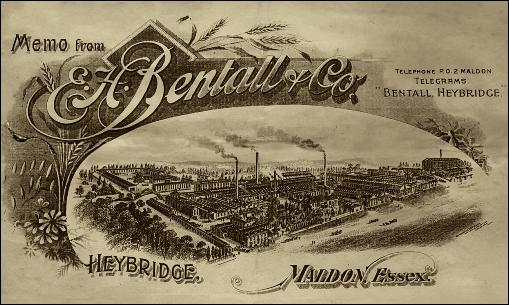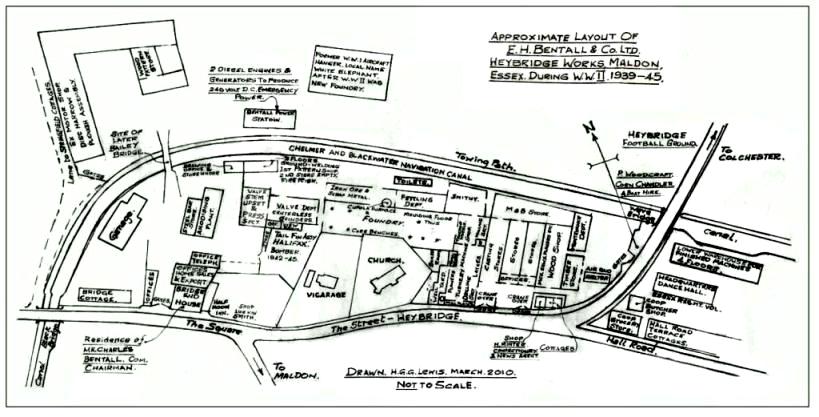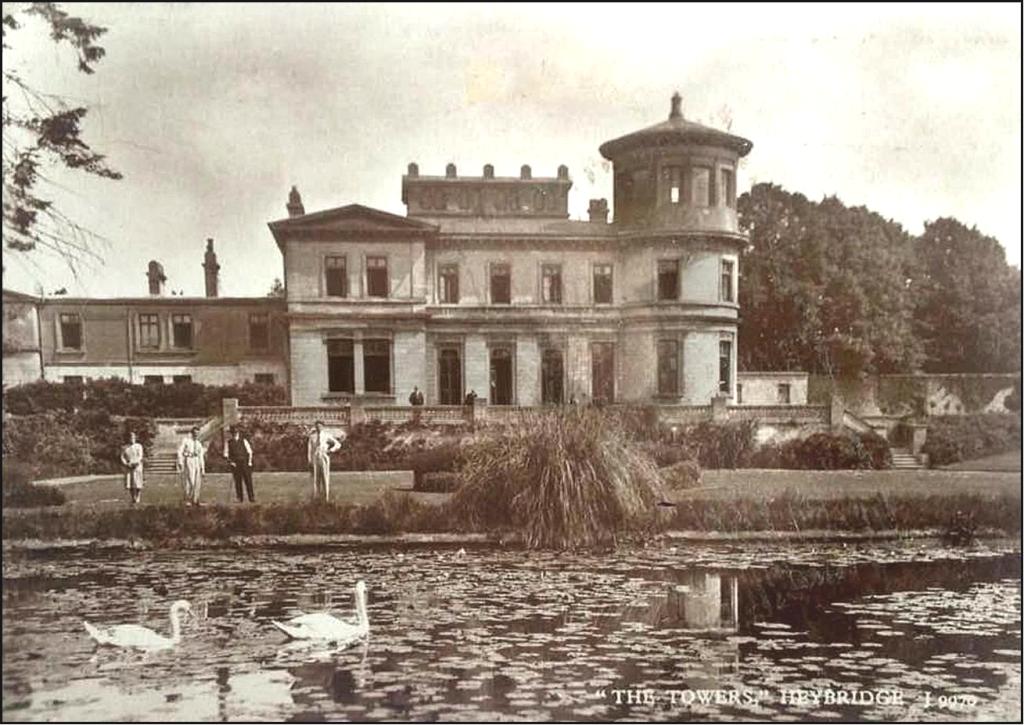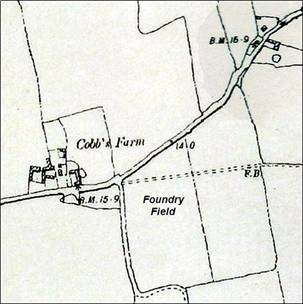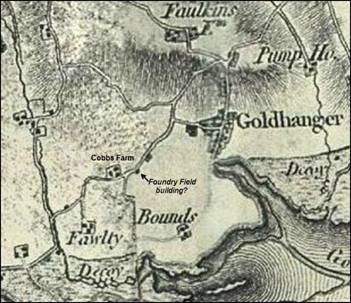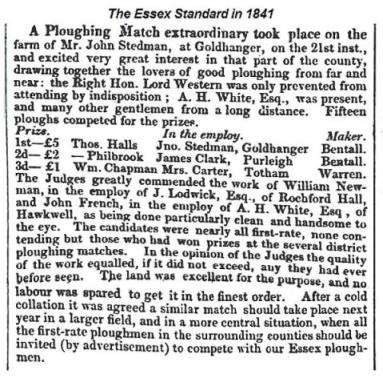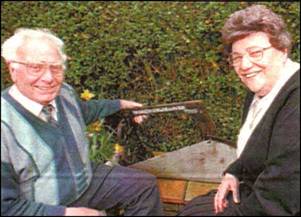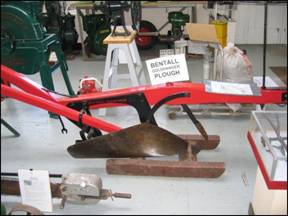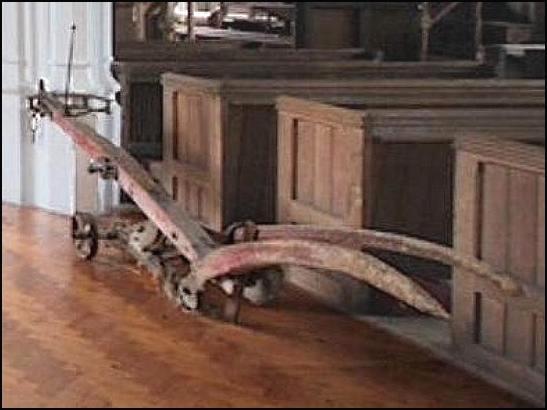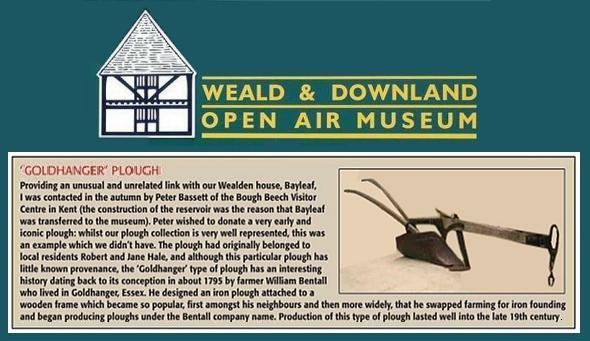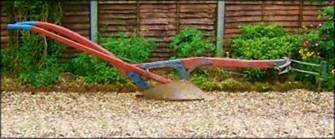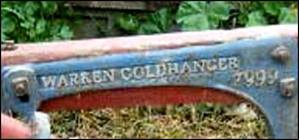William Bentall
1776 - 1836
|
|
|
William
Bentall invented the Goldhanger Plough while living at Cobbs
Farm Goldhanger in the late 1700s. It was so efficient that other local farmers
asked him to make one for them. The ploughs were initially made by the local
blacksmith, but William Bentall soon opened a small foundry and smithy on land
opposite his farmhouse as demand grew. His plough became well known around the
world for over a century and had the named the 'Bentall Goldhanger' cast into
the iron casing, as shown on the left here...
|
select to enlarge and zoom in |
a Goldhanger plough at work in 1930s |
|
at Rochford in Essex |
a Goldhanger plough at work |
However
he did not patent the design and the Warren Ironwork on the Maldon Causeway and
others produced imitations using the “Goldhanger” name.
William
was descended from a long line of the Bentall family that lived in Benthall
Hall in Shropshire, and another branch of the same family developed a small
haberdashery shop at Kingston-upon-Thames into the now famous very large
departmental store.
|
|
|
|
|
|
|
|
|
In 1795 William Bentall became a manufacturer of
agricultural machinery based in Goldhanger and ceased farming. He realised however
that raw materials had to be imported and finished products shipped out by
water and rail, and Cobbs Farm was not the ideal location, so in 1805 he
located his works on the banks of the recently opened Chelmer and Blackwater
canal at Heybridge, just three miles away. Raw materials could then be brought
directly up the canal in lighters to the new works.
the Goldhanger Plough doesn’t appear to have been
significantly different to other ploughs of that era, but one of the reasons
Bentall’s plough was so successful was its modular design and construction
using separate replaceable parts with nuts and bolts, so that the plough could
be repaired by the farmer without the need to transport it to a blacksmiths.
Bentall developed the technique for mass-production of large strong nuts and
bolts to be able to mass-produce the ploughs.
The innovations continued and in the year following
the move to Heybridge William Bentall introduced the first steam powered
threshing machine followed by many other agricultural implements. William
Bentall never took out patents on his designs but relied on customer
satisfaction to ensure the continued success of his products. The Bentall name
stood for quality and his factory always ran at maximum capacity. In 1836
William Bentall was succeeded by his son Edward Hammond Bentall and
subsequently by several generations of the Bentall family. In order to
safeguard the expanding business in 1839 the company began trading under the
name of E.H.Bentall & Co. and in 1841 a patent was taken out for an "improved Goldhanger plough" to protect the product against imitations. . .
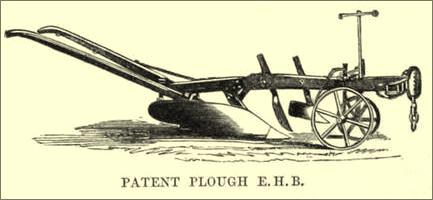
The success of the Company can be seen from an
extract from sales documents...
and this Essex Show on the
Causeway in Maldon in the early 1900s
with a row of Goldhanger
Ploughs in the foreground...
here is a site drawing as it
was during WW-2...
and here is a lithographic
drawing of the warehouse by the canal and a photos of the family home...
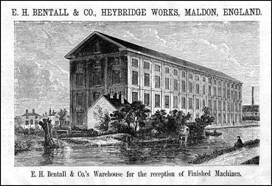
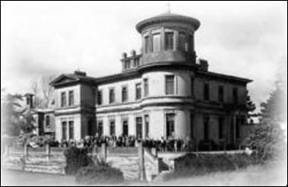
At its peak just before WW1 the company employed
around 700 people, and many of these were accommodated in houses provided by
the Company adjacent to the factory. The first workers houses were built as
long ago as 1815 when William was still managing the business. This terrace of
red-brick cottages, now listed, were built in the Holloway Road, near The
Square and opposite the family main residence and offices at the time, which
much later became the Benbridge Hotel. . .
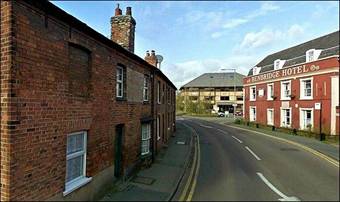
In 1961 the company was taken over by the Acrow
group of companies which itself went into receivership in 1984, so the business
that was founded nearly 180 years ago was finally closed down. However, one of
todays agricultural companies still has past links with Bentalls and the
Goldhanger Plough.
From. . . www.bentallrowlands.com/about-us/history . .
Bentall Rowlands Storage Systems
Limited
can trace its origins back to the industrial and agricultural revolutions that
sent waves of influence around the world. In the middle of the 18th century,
William Bentall, an Essex agricultural engineer, designed the famous Goldhanger
plough. Its design was so state
of the art it remained in production until 1947. Over the years the Company
passed from father to son - always innovative - always successful. Patents and
designs followed rapid succession and by the late 19th century it had even
diversified into the design and manufacture of yachts and motor cars. The
Company grew and developed, exporting its products throughout the world. In
1961 the Acrow Group acquired the Company and rationalised it to concentrate on
coffee machinery, bulk storage and handling equipment. In the early 1980s the
Bentall companies were sold and moved to Scunthorpe. In 1988 the new company
acquired Rowlands Engineers and amalgamated its bulk storage and handling
business with that of Bentalls, all manufacturing being at the Scunthorpe site.
__________________________
extract from. . .
http://unlockingessex.essexcc.gov.uk
Monument Name: Goldhanger Iron Foundry SMR Number:
15303
The Goldhanger foundry was established by W. Bentall
in 1808, but had closed by 1815 when Bentall moved the foundry from Goldhanger
to Heybridge. Foundry field lies immediately east of Cobbs Farm and to the
south of Maldon Road, and is recorded on the 1841 tithe map (ERO/D/CT 150) as
field 132. Although no structural evidence survives the foundry was probably
sited toward the north of the field beside the road. The field has not been
excavated but has potentially important deposits of a short lived early
nineteenth-century foundry comprising footings, foundations, working floors and
furnace beds. This is of one of the earliest iron foundries to be established
in Essex. The short period of operation and lack of subsequent development
suggests the presence of significant and potentially schedulable archaeological
remains.
The
location of the Foundry Field is identified on both the 1820 Tithe Map &
Awards and the 1838 Tithe Map Tithe Awards. In both Awards listings it is entry
132. In both the owner is given as Henry Coape and the occupier
(farmer?) as James Wood. In the 1838 Tithe Awards it is listed as:
![]()
The field is
identified on English Heritage maps of listed sites, and a 1805 map show a
small building in the north-east corner of this field. . .
|
|
|
A report of an
Archaeological Evaluation of Cobbs Farm lands undertaken in 2009, records. . .
. . .Goldhanger Iron Foundry was formerly located to
the east of the site (EHER 15303). The foundry was established by W Bentall in
1808 but closed by 1815 to move to a site in Heybridge, the location shows
potential for important archaeological remains of an early iron foundry. . .
In 1820 the date
of the earlier Tithe Map & Awards, Cobbs Farmhouse, or homestead was recorded as in the ownership of Henry Coape
with the occupier as James Wood, so presumable William was living in
Heybridge by this time. However, in the same Tithe Awards document, William
Bentall is recorded as being the owner of thirteen cottages in Goldhanger
Parish, including a carpenters shop and the Pit
cottages, which were being used as the village school
at that time. They were still listed as in his ownership in Tithe Awards of
1838, which was two years after his recorded death.
These local newspapers advertisements would indicate that William continued to be the occupier and proprietor of property at Goldhanger until his death. . .
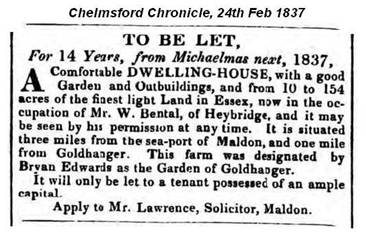
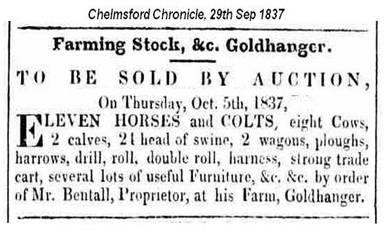
__________________________
In 1815 William Bentall had an iron chest made for St Peters Church, which remains in the Church today,
and later his son Edward presented a set of iron gates to the Church also in
recognition of the Company connections with the village. . .
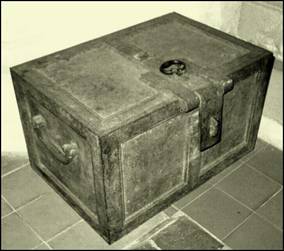
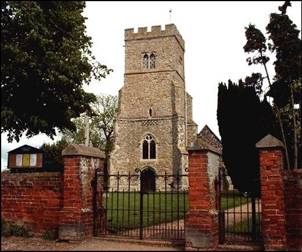
There have been other links between the Bentall family
and Goldhanger. Second Lieutenant Earnest Hammed Bentall Bentall, son of Edmund
and Maude Bentall, served in WW-1 and was killed in action. His family
purchased the former Sergeants Mess hut from Goldhanger
aerodrome site, moved it to Heybridge Basin and commissioned it as St
Georges Chapel in memory of their son. It has a fine stained glass window at
the east end dedicated to their son. At the same time the Company acquired a
redundant WW-1 aircraft hanger, which most probably came from the nearby
Goldhanger aerodrome and May & Butcher who purchased many of the
building from the site and sold them on. It was re-built on the Bentall factory
site, but was never apparently used and became known as The White Elephant. It was finally removed and replaced by a new
foundry building in 1949.
__________________________
These two advertisements appeared in of a local newspaper adjacent to each other on the same day in 1850. Both refer to the Goldhanger Plough, and both claiming to have made improvements. . .
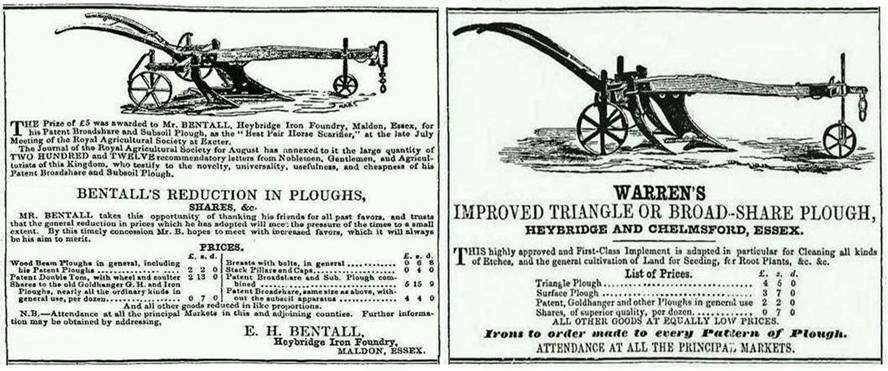
and this drawing was in the 1851 Great Exhibition catalogue...
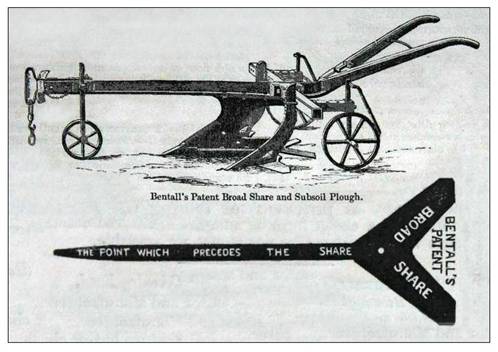
__________________________
Here is a newspaper report
of a ploughing match held in Goldhanger in 1841. At the time Mr Steadman was
the farmer at Hall Farm. The Prize winners had
used Bentall and Warren ploughs...
__________________________
Over the years several
Goldhanger ploughs have been preserved locally. . .
- Maura Benham
had one in her garden in Goldhanger
- Cyril
Southgate also had one in his garden in Goldhanger
- There was one in the Maldon & District
Agricultural & Domestic Museum at Goldhanger
- One can be seen at the Museum of Power at Langford
- There is one at in the Chaff Room the Cressing Temple
Barn.
- There is one inside the Parish Church at Layer
Marney
- There is one in the Weald & Downland Museum in
Kent
- A plough was offered for sale at Chappel, Essex in
2008 for ₤200
- Others remain in private hands locally
|
Cyril and Eileen with their
Goldhanger Plough |
the plough at the Museum of
Power |
|
|
Goldhanger Plough in Layer
Marney Parish church |
in the Weald & Downland Museum |
|
|
a Pagetted impression of a
Goldhanger Plough built into the Village School as part of the 1986 extension |
||
|
There are also Warren
Goldhanger Ploughs held locally, which are very similar in appearance . . . |
||
|
|
|
|
|
Even in 1930 it seems it
was still good enough for the
locals. . .
|
||
Beryl Claydon book entitled: Heybridge in the Nineteenth and Twentieth
Centuries, published in 2012, devotes 33 pages to the
history of the Bentall family and the Company, from which some of the
information on this page has been taken.
__________________________
top characters from the past home
